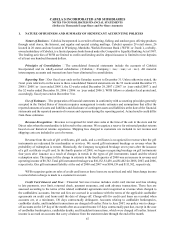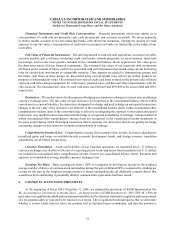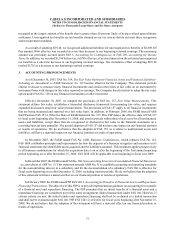Cabela's 2008 Annual Report Download - page 74
Download and view the complete annual report
Please find page 74 of the 2008 Cabela's annual report below. You can navigate through the pages in the report by either clicking on the pages listed below, or by using the keyword search tool below to find specific information within the annual report.69
CABELA’S INCORPORATED AND SUBSIDIARIES
NOTES TO CONSOLIDATED FINANCIAL STATEMENTS
(Dollars in Thousands Except Share and Per Share Amounts)
Inventories – Inventories are stated at the lower of cost or market. All inventories are finished goods. The
reserve for inventory shrinkage, estimated based on cycle counts and physical inventories, was $9,825 and $6,875 at
the end of 2008 and 2007, respectively. The reserves for returns of damaged goods, obsolescence, and slow-moving
items, estimated based upon historical experience, inventory aging, and specific identification, were $6,626 and
$6,805 at the end of 2008 and 2007, respectively.
Vendor Allowances – Vendor allowances include price allowances, volume rebates, store opening costs
reimbursements, marketing participation, and advertising reimbursements received from vendors under vendor
contracts. Vendor merchandise allowances are recognized as a reduction of the costs of merchandise as sold. Vendor
reimbursements of costs are recorded as a reduction to expense in the period the related cost is incurred based on
actual costs incurred. Any cost reimbursements exceeding expenses incurred are recognized as a reduction of the
cost of merchandise sold. Volume allowances may be estimated based on historical purchases and estimates of
projected purchases.
Deferred Catalog Costs and Advertising – Advertising production costs are expensed as the advertising occurs
except for catalog costs which are amortized over the expected period of benefit estimated at 3 to 12 months after
mailing. Unamortized catalog costs totaled $31,015 and $32,569 at the end of 2008 and 2007, respectively. Advertising
expense, including catalog costs amortization, and website marketing paid search fees, was $212,379, $207,373, and
$191,533 for 2008, 2007, and 2006, respectively. Advertising vendor reimbursements netted in advertising expense
above totaled $1,834, $7,058, and $4,546 for 2008, 2007, and 2006, respectively.
Store Pre-opening Expenses – Non-capital costs associated with the opening of new stores are expensed as
incurred.
Leases – We lease certain retail locations, distribution centers, office space, equipment and land. Assets held
under capital lease are included in property and equipment. Operating lease rentals are expensed on a straight-line
basis over the life of the lease. At the inception of a lease, we determine the lease term by assuming the exercise
of those renewal options that are reasonably assured because of the significant economic penalty that exists for
not exercising those options. The exercise of lease renewal options is at our sole discretion. The expected lease
term is used to determine whether a lease is capital or operating and is used to calculate straight-line rent expense.
Additionally, the depreciable life of buildings and leasehold improvements is limited by the expected lease term.
Property and Equipment – Property and equipment are stated at cost. Depreciation and amortization are
provided over the estimated useful lives of the assets, including assets held under capital leases, on a straight-line basis.
Leasehold improvements are amortized over the lease term or, if shorter, the useful lives of the improvements. Assets
held under capital lease agreements are amortized using the straight-line method over the shorter of the estimated
useful lives of the assets or the lease term. The costs of major improvements that extend the useful life of an asset are
capitalized. Long-lived assets are reviewed for impairment whenever events or changes in circumstances indicate
that the carrying amount of an asset may not be recoverable. Capitalized interest on projects during the construction
period totaled $2,472, $4,069, and $355, for 2008, 2007, and 2006, respectively. Costs related to internally developed
software are capitalized and amortized on a straight-line basis over their estimated useful lives.
Intangible Assets – Intangible assets are recorded in other assets and include non-compete agreements and
goodwill. At the end of 2008 and 2007, intangible assets totaled $5,902 and $8,123, net of accumulated amortization
of $2,132 and $4,509, respectively. During the fourth quarter of 2008, we completed our annual impairment analyses
of goodwill and other intangible assets and recognized an impairment of $1,070, which is recorded in selling,
distribution, and administrative expenses in our Direct segment where projected discounted cash flows were less
than the fair value of the reporting unit.
























